Discover 35 hidden attractions, cool sights, and unusual things to do in Manchester (United Kingdom). Don't miss out on these must-see attractions: Museum of Science and Industry, Manchester Art Gallery, and Imperial War Museum North. Also, be sure to include Oldham Street in your itinerary.
Below, you can find the list of the most amazing places you should visit in Manchester (England).
Table of Contents
Museum of Science and Industry

History in an 1830 railway station. The Science and Industry Museum in Manchester, England, traces the development of science, technology and industry with emphasis on the city's achievements in these fields. The museum is part of the Science Museum Group, a non-departmental public body of the Department for Digital, Culture, Media and Sport, having merged with the National Science Museum in 2012.
There are extensive displays on the theme of transport (cars, aircraft, railway locomotives and rolling stock), power (water, electricity, steam and gas engines), Manchester's sewerage and sanitation, textiles, communications and computing.
The museum is an Anchor Point of the European Route of Industrial Heritage and is on the site of the world's first passenger railway station – Manchester Liverpool Road – which opened as part of the Liverpool & Manchester Railway in 1830. The railway station frontage and 1830 warehouse are both Grade I listed.[1]
Address: Liverpool Road, M3 4FP Manchester
Manchester Art Gallery

Prominent paintings and decorative arts. Manchester Art Gallery, formerly Manchester City Art Gallery, is a publicly owned art museum on Mosley Street in Manchester city centre. The main gallery premises were built for a learned society in 1823 and today its collection occupies three connected buildings, two of which were designed by Sir Charles Barry. Both Barry's buildings are listed. The building that links them was designed by Hopkins Architects following an architectural design competition managed by RIBA Competitions. It opened in 2002 following a major renovation and expansion project undertaken by the art gallery.
Manchester Art Gallery is free to enter and open seven days a week. It houses many works of local and international significance and has a collection of more than 25,000 objects. More than half a million people visited the museum in the period of a year, according to figures released in April 2014.[2]
Address: Mosley St, M2 3JL Manchester
Imperial War Museum North
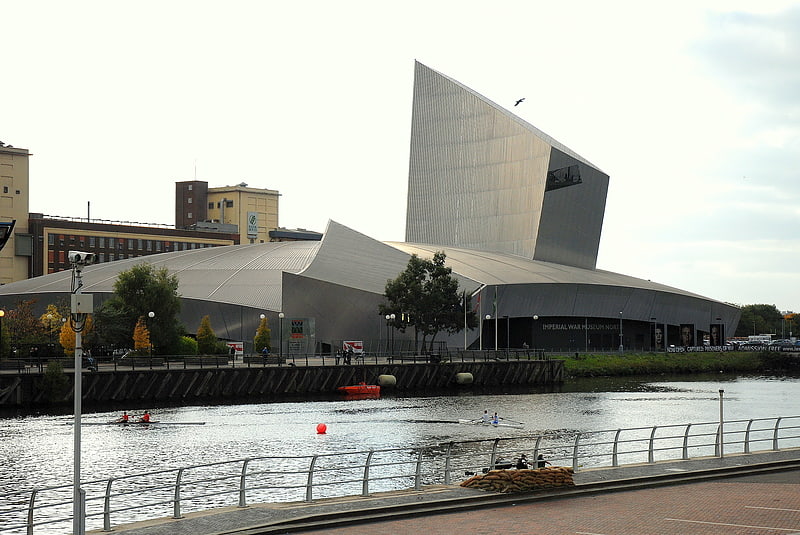
Museum of conflict in symbolic building. Imperial War Museum North is a museum in the Metropolitan Borough of Trafford in Greater Manchester, England. One of five branches of the Imperial War Museum, it explores the impact of modern conflicts on people and society. It is the first branch of the Imperial War Museum to be located in the north of England. The museum occupies a site overlooking the Manchester Ship Canal on Trafford Wharf Road, Trafford Park, an area which during the Second World War was a key industrial centre and consequently heavily bombed during the Manchester Blitz in 1940. Just across the Trafford Wharf Road from the Museum is the bulk of the Rank Hovis Flour Mill, a survivor from a former industrial age and now rather out of keeping with the surrounding architecture. The area is now home to the Lowry cultural centre and the MediaCityUK development, which stand opposite the museum at Salford Quays.
The museum building was designed by architect Daniel Libeskind and opened in July 2002, receiving 470,000 visitors in its first year of opening. It was recognised with awards or prize nominations for its architecture and is a prime example of Deconstructivist architecture. The museum features a permanent exhibition of chronological and thematic displays, supported by hourly audiovisual presentations which are projected throughout the gallery space. The museum also hosts a programme of temporary exhibitions in a separate gallery. Since opening, the museum has operated a successful volunteer programme, which since January 2007 has been run in partnership with Manchester Museum. As part of a national museum, Imperial War Museum North is financed by the Department for Culture, Media and Sport and by self-generated income. Admission is free.[3]
Address: Trafford Wharf Rd, M17 1TZ Manchester (Trafford)
Oldham Street

Street in Manchester, England. Oldham Street is in Manchester city centre and forms part of the city's historic Northern Quarter district. The Northern Quarter is dominated by buildings that were built before World War II.
The street runs from Piccadilly to Great Ancoats Street on the edge of Ancoats, beyond which it continues northwards as Oldham Road, the A62. The street is part of Manchester which is on a tentative list as a UNESCO World Heritage Site.
The Methodist Central Hall stands on the east side.
Until the 1970s Oldham Street formed one of the principal shopping areas of Manchester city centre. However the construction of the large indoor Arndale Centre during this decade to the west saw most of the well known and long established high street stores close or relocated.[4]
Address: Oldham St, Manchester
Albert Square
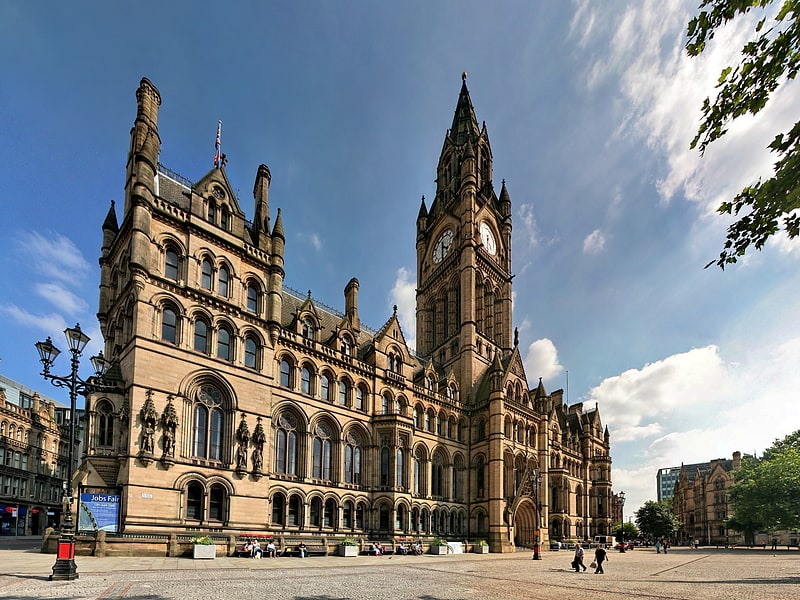
Albert Square is a public square in the centre of Manchester, England. It is dominated by its largest building, the Grade I listed Manchester Town Hall, a Victorian Gothic building by Alfred Waterhouse. Other smaller buildings from the same period surround it, many of which are listed.
The square contains a number of monuments and statues, the largest of which is the Albert Memorial, a monument to Prince Albert, Prince consort of Queen Victoria. The square, named after the Prince, was laid out to provide a space for the memorial in 1863–67. Work on the town hall began in 1868 and was completed in 1877.[5]
Address: Albert Square, manchester, Manchester
Heaton Park
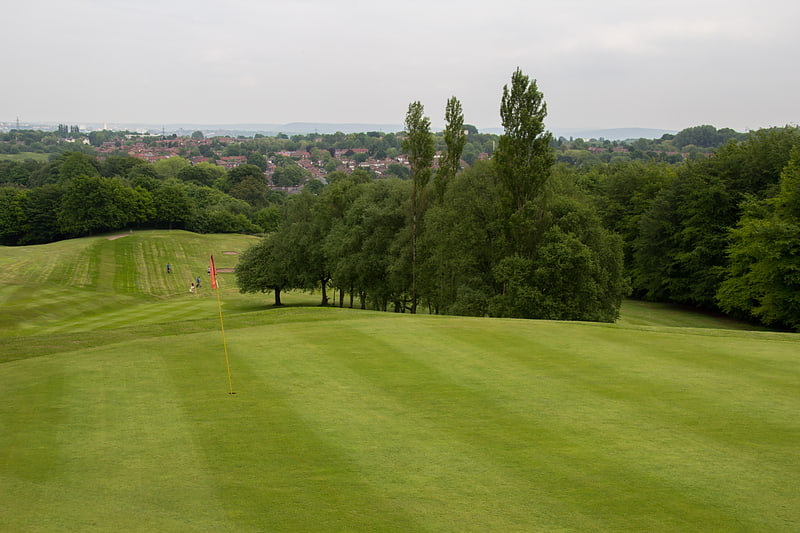
Museum in Manchester, England. Heaton Park is a municipal park in Manchester, England, covering an area of over 600 acres. The park includes the grounds of a Grade I listed, neoclassical 18th century country house, Heaton Hall. The hall, remodelled by James Wyatt in 1772, is now only open to the public on an occasional basis as a museum and events venue.
Heaton Park was sold to Manchester City Council in 1902 by the Earl of Wilton. It has one of the United Kingdom's few concrete towers, the Heaton Park BT Tower.
The park was renovated as part of a millennium project partnership between the Heritage Lottery Fund and Manchester City Council at a cost of over £10 million. It contains an 18-hole golf course, a boating lake, an animal farm, a pitch and putt course, a golf driving range, woodlands, ornamental gardens, an observatory, an adventure playground, a Papal monument and a volunteer-run tram system and museum, and is listed Grade II by Historic England. It has the only flat green bowling greens in Manchester, built for the 2002 Commonwealth Games.[6]
Address: Middleton Rd, M25 2SW Manchester
Corporation Street
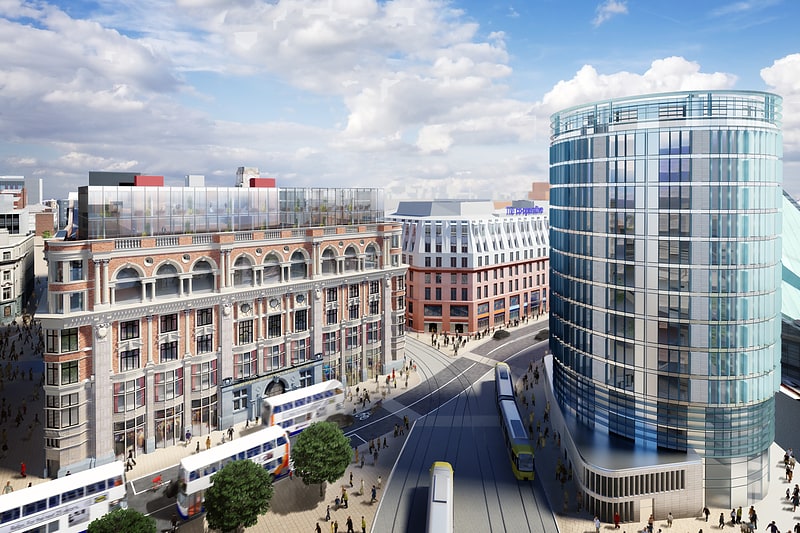
Thoroughfare in Manchester, England. Corporation Street is a major thoroughfare in Manchester city centre. It runs from Dantzic Street to the junction of Cross Street and Market Street. Major buildings located on or adjacent to the street include the Arndale Centre, Exchange Square, The Printworks, Urbis and New Century Hall next to the CIS Tower.
After the street was bombed in 1996 by the Provisional IRA, the vicinity has undergone large scale reconstruction. The area around Corporation Street has been a likely target for several planned terrorist attacks, most recently in 2009. To reduce this threat, the street is partly pedestrianised between Market Street and Withy Grove between 1100 and 1900 hours. A series of bollards have been installed that grant access only to authenticated emergency service vehicles and buses.[7]
Address: Corporation St, Manchester
Market Street

Street in Manchester, England. Market Street is one of the principal retail streets in Manchester, England. It runs from its junction with Piccadilly and Mosley Street, close to Piccadilly Gardens, in the east to where it meets St. Mary's Gate at the crossroads with Exchange Street and New Cathedral Street in the west. St Mary's Gate then continues to where it meets Deansgate. Other major streets crossed are High Street, Corporation Street, Cross Street and Fountain Street.[8]
Address: Market St, M2 Manchester
Manchester Cathedral
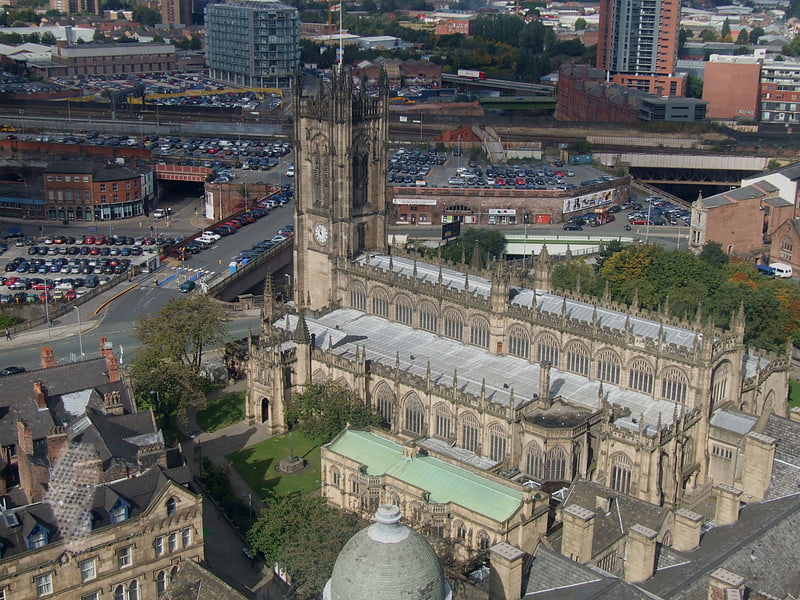
Place of worship with Medieval origins. Manchester Cathedral, formally the Cathedral and Collegiate Church of St Mary, St Denys and St George, in Manchester, England, is the mother church of the Anglican Diocese of Manchester, seat of the Bishop of Manchester and the city's parish church. It is on Victoria Street in Manchester city centre and is a grade I listed building.
The former parish church was rebuilt in the Perpendicular Gothic style in the years following the foundation of the collegiate body in 1421. Then at the end of the 15th century, James Stanley II (warden 1485–1506 and later Bishop of Ely 1506–1515) was responsible for rebuilding the nave and collegiate choir with high clerestory windows; also commissioning the late-medieval wooden internal furnishings, including the pulpitum, choir stalls and the nave roof supported by angels with gilded instruments. The collegiate church became the cathedral of the new Diocese of Manchester in 1847. It was extensively refaced, restored and extended in the Victorian period, and again following bomb damage during World War II. It is one of fifteen Grade I listed buildings in Manchester.[9]
Address: Of Deansgate Victoria Street, M3 1SX Manchester
Manchester Town Hall
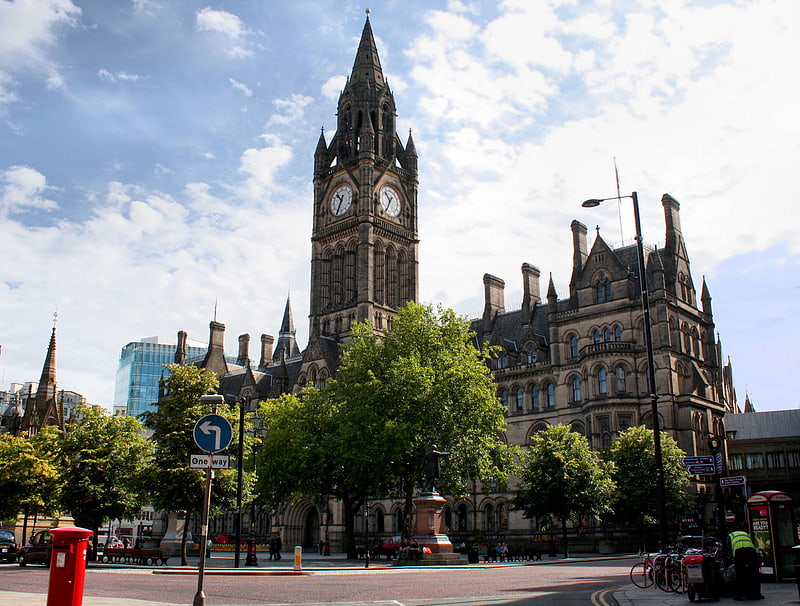
Building in Manchester, England. Manchester Town Hall is a Victorian, Neo-gothic municipal building in Manchester, England. It is the ceremonial headquarters of Manchester City Council and houses a number of local government departments. The building faces Albert Square to the north and St Peter's Square to the south, with Manchester Cenotaph facing its southern entrance.
Designed by architect Alfred Waterhouse, the town hall was completed in 1877. The building contains offices and grand ceremonial rooms such as the Great Hall which is decorated with Ford Madox Brown's imposing Manchester Murals illustrating the history of the city. The entrance and Sculpture Hall contain busts and statues of influential figures including Dalton, Joule and Barbirolli. The exterior is dominated by the clock tower which rises to 280 feet (85 m) and houses Great Abel, the clock bell.
In 1938, a detached Town Hall Extension was completed and is connected by two covered bridges over Lloyd Street. The town hall was designated as a Grade I listed building on 25 February 1952.[10]
Eccles Town Hall
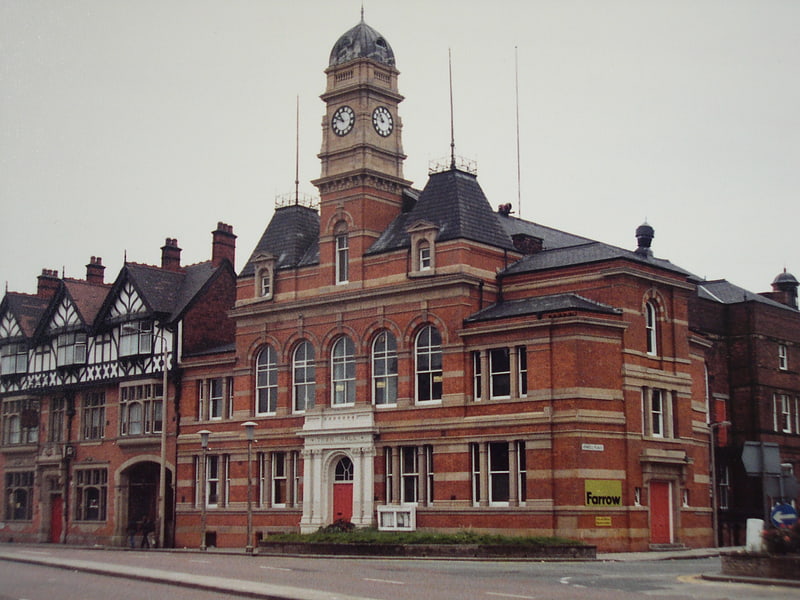
Function room facility in Eccles, England. Eccles Town Hall is a municipal building in Church Street, Eccles, Greater Manchester, England. The town hall was the headquarters of Eccles Borough Council until the council was abolished in 1974.[11]
Address: 28 Barton Lane, Manchester (Salford)
Piccadilly Gardens
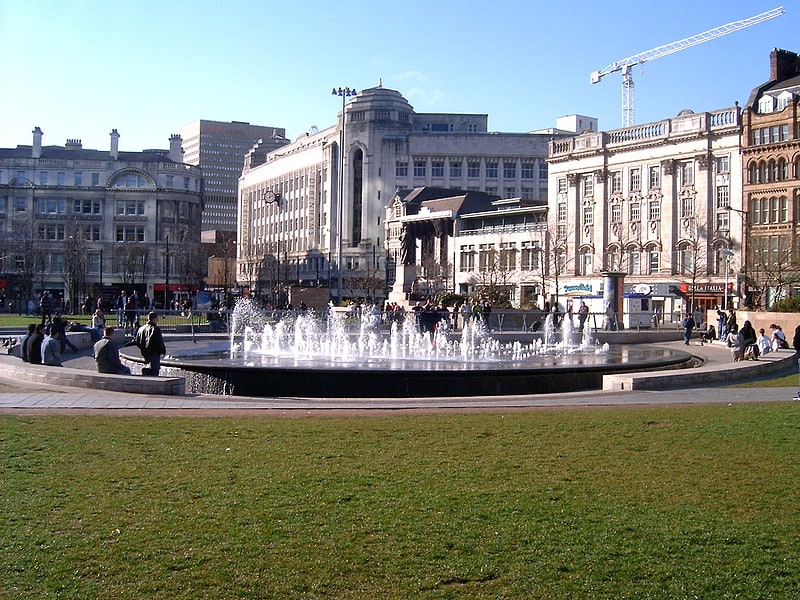
Park in Manchester, England. Piccadilly Gardens is a green space in Manchester city centre, England, on the edge of the Northern Quarter.
It takes its name from the adjacent street, Piccadilly, which runs across the city centre from Market Street to London Road. The gardens also contain a bus station and a tram stop.
Piccadilly Gardens were laid out after World War I on the former site of the Manchester Royal Infirmary. Originally landscaped as an ornamental sunken garden, the area was levelled out and reconfigured in 2002 with a water feature and concrete pavilion by Japanese architect Tadao Ando.[12]
National Football Museum
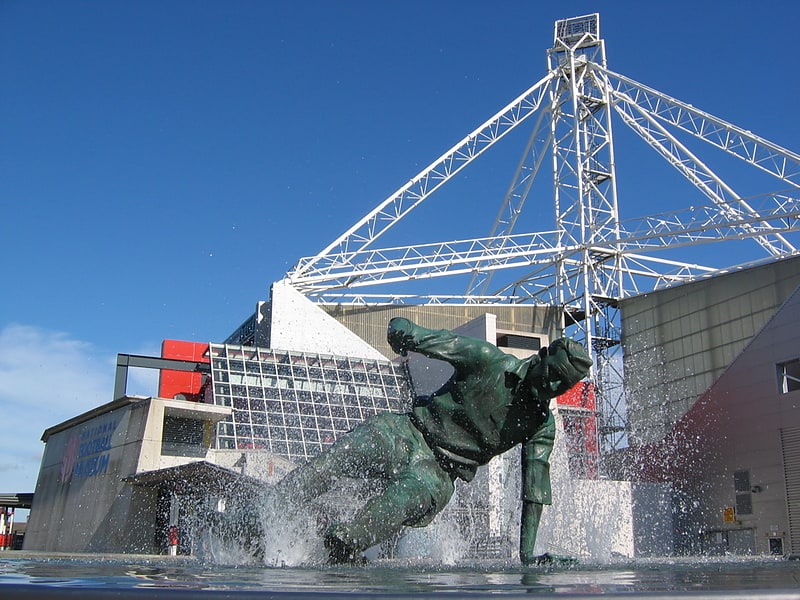
Exhibitions on soccer past and present. The National Football Museum is England's national museum of football. It is based in the Urbis building in Manchester city centre, and preserves, conserves and displays important collections of football memorabilia.
The museum was originally based in Deepdale, Preston, Lancashire, but moved to Manchester in 2012.[13]
Address: Cathedral Gardens, M4 3BG Manchester
Manchester Museum
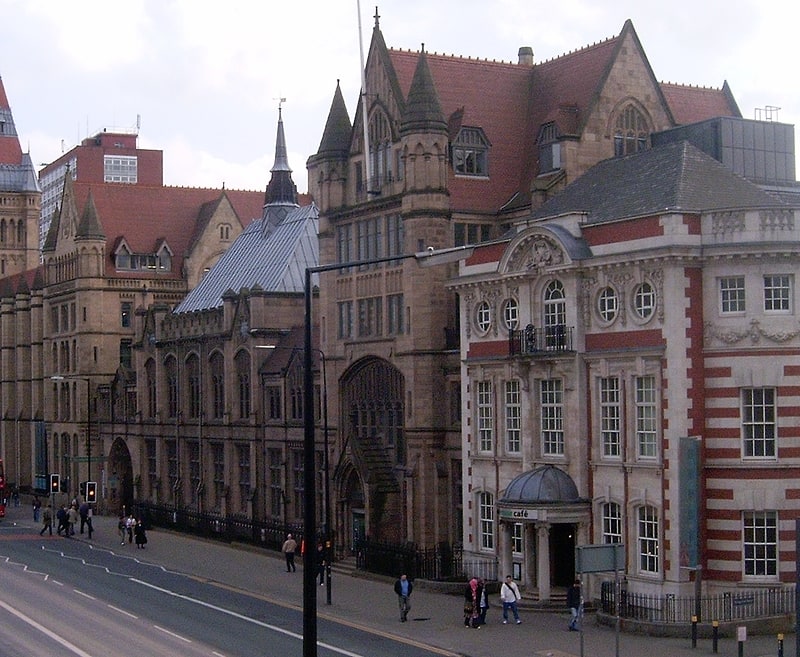
Key ethnography and natural history venue. Manchester Museum is a museum displaying works of archaeology, anthropology and natural history and is owned by the University of Manchester, in England. Sited on Oxford Road at the heart of the university's group of neo-Gothic buildings, it provides access to about 4.5 million items from every continent. It is the UK's largest university museum and serves both as a major visitor attraction and as a resource for academic research and teaching. It has around 430,000 visitors each year.[14]
Address: Oxford Rd, M13 9PL Manchester
Manchester Cenotaph
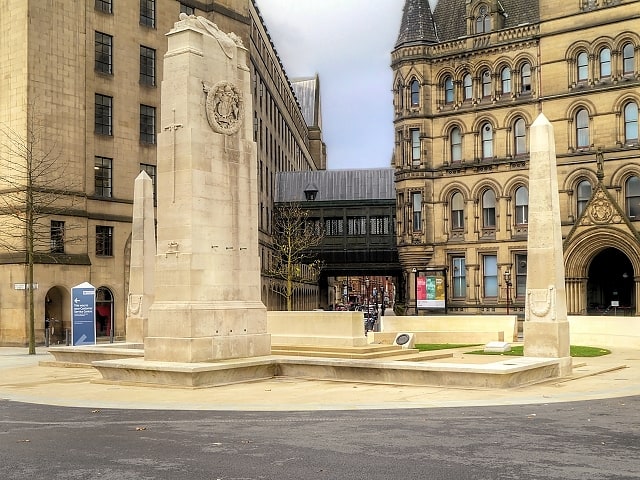
Historical landmark in Manchester, England. Manchester Cenotaph is a war memorial in St Peter's Square, Manchester, England. Manchester was late in commissioning a First World War memorial compared with most British towns and cities; the city council did not convene a war memorial committee until 1922. The committee quickly achieved its target of raising £10,000 but finding a suitable location for the monument proved controversial. The preferred site in Albert Square would have required the removal and relocation of other statues and monuments, and was opposed by the city's artistic bodies. The next choice was Piccadilly Gardens, an area already identified for a possible art gallery and library; but in the interests of speedier delivery, the memorial committee settled on St Peter's Square. The area within the square had been had been purchased by the City Council in 1906, having been the site of the former St Peter's Church; whose sealed burial crypts remained with burials untouched and marked above ground by a memorial stone cross. Negotiations to remove these stalled so the construction of the cenotaph proceeded with the cross and burials in situ.
Having picked a site, it was originally proposed to choose an architect by open competition, but the memorial committee was criticised in the local press when it reserved the right to overrule the judgement of the independent assessor. A sub-committee therefore approached Sir Edwin Lutyens directly, who produced, in a matter of weeks, a variation of his design for the Cenotaph in London. The memorial consists of a central cenotaph and a Stone of Remembrance flanked by twin obelisks, all features characteristic of Lutyens' works. Raised steps either side of the Stone of Remembrance provided east-facing tribunes for the colour party in memorial parades. The cenotaph is topped by an effigy of a fallen soldier and decorated with relief carvings of the imperial crown, Manchester's coat of arms and inscriptions commemorating the dead. The structures, based on classical architecture, use abstract, ecumenical shapes rather than overt religious symbolism. In submitting the design, Lutyens stated that he envisaged the crypts and cross as remaining in place; as the cenotaph could stand on the foundations of the former church tower and the cross would serve to "consecrate the site", while there would be no explicit religious symbolism on the cenotaph itself.
The memorial was unveiled on 12 July 1924 by the Earl of Derby, assisted by Mrs Bingle, a local resident whose three sons had died in the war. It cost £6,940 and the remaining funds were used to provide hospital beds.
In 2014, Manchester City Council dismantled the memorial and reconstructed it at the northeast corner of St Peter's Square next to Manchester Town Hall to make room for the expanded Metrolink tram network. It is a grade II* listed structure and in 2015, Historic England recognised Manchester Cenotaph as part of a national collection of Lutyens' war memorials.[15]
The Lowry

Theatre in Salford, England. The Lowry is a theatre and gallery complex at Salford Quays, Salford, Greater Manchester, England. It is named after the early 20th-century painter L. S. Lowry, known for his paintings of industrial scenes in North West England. The complex opened on 28 April 2000 and was officially opened on 12 October 2000 by Queen Elizabeth II.[16]
Address: Pier 8, M50 3AZ Salford Quays (Salford)
Old Trafford Cricket Ground
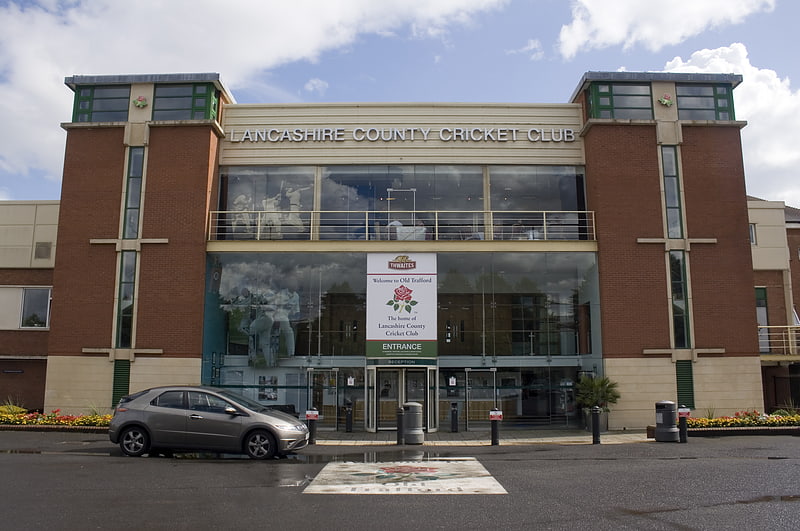
Internationally famous sporting venue. Old Trafford is a cricket ground in Old Trafford, Greater Manchester, England. It opened in 1857 as the home of Manchester Cricket Club and has been the home of Lancashire County Cricket Club since 1864. From 2013 onwards it has been known as Emirates Old Trafford due to a sponsorship deal with the Emirates airline.
Old Trafford is England's second oldest Test venue after The Oval and hosted the first Ashes Test in England in 1884. The venue has hosted the Cricket World Cup five times (1975, 1979, 1983, 1999 and 2019). Old Trafford holds the record for both most World Cup matches hosted (17) and most semi-finals hosted (5). In 1956, the first 10-wicket haul in a single innings was achieved by England bowler Jim Laker who achieved bowling figures of 19 wickets for 90 runs—a bowling record which is unmatched in Test and first-class cricket. In 1990, a 17 year old Sachin Tendulkar scored 119 not out against England, which was the first of his 100 international centuries. In the 1993 Ashes Test at Old Trafford, leg-spinner Shane Warne bowled Mike Gatting with the "Ball of the Century". In 2019, New Zealand defeated India in the World Cup semi-final after infamously running out MS Dhoni, in what turned out to be his last international match. In 2020 the ground was used as one of two biosecure venues, alongside the Ageas Bowl, for the tours involving West Indies and Pakistan which were regulated due to the COVID-19 pandemic.
After Old Trafford lost test status in 2009, extensive redevelopment of the ground to increase capacity and modernise facilities entailed the restoration of the pavilion and creation of The Point, a £12 million stand overlooking the pitch.[17]
Address: Talbot Road, M16 0PX Stretford (Trafford)
Elizabeth Gaskell's House
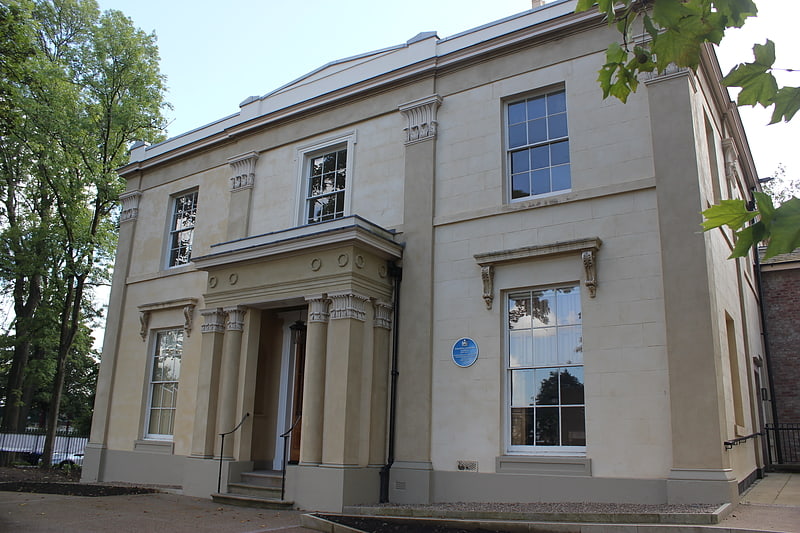
84 Plymouth Grove, now known as Elizabeth Gaskell's House, is a writer's house museum in Manchester. The Grade II* listed neoclassical villa was the residence of William and Elizabeth Gaskell from 1850 till their deaths in 1884 and 1865 respectively. The Gaskell household continued to occupy the villa after the deaths of Elizabeth and William. The death of Elizabeth Gaskell's daughter, Margaret Emily "Meta" Gaskell, in 1913, brought to an end the Gaskells' residence there.
The house itself was granted listed building status in 1952, partly due to its association with the Gaskells. This granted it protection from demolition, however, 84 Plymouth Grove slowly descended into a state of disrepair due to neglect.
The Manchester Historic Buildings Trust commenced a restoration project in 2009, aiming to see 84 Plymouth Grove returned to its state as the Gaskells left it. By 2011, the Trust had finished the exterior, which included structural repairs and removing the pink paint that had coated the house for various years. However, in May 2011 their project was marred by the theft of the lead roof, which caused "extensive damage" according to the BBC. On completion of the £2.5m restoration, the building was reopened to the public on 5 October 2014.[18]
Address: 84 Plymouth Grove, M13 9LW Manchester
Whitworth Art Gallery
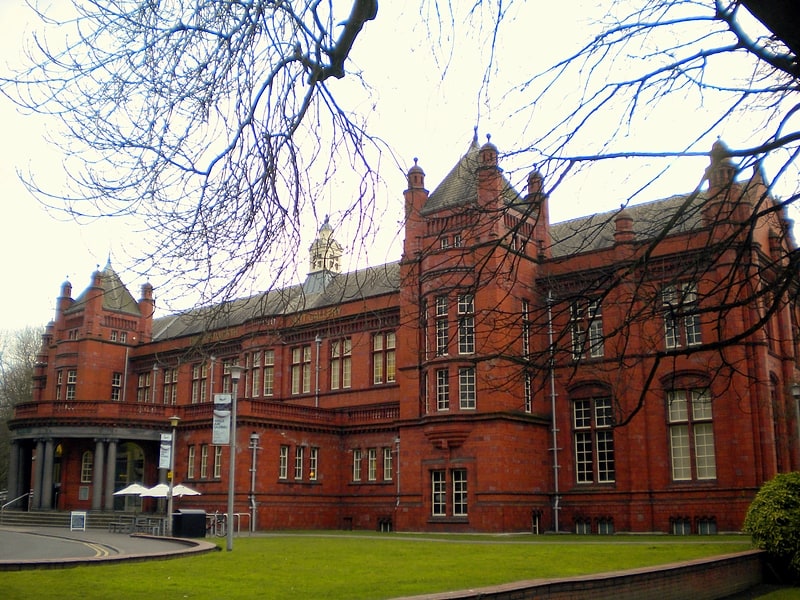
Art gallery in Manchester, England. The Whitworth is an art gallery in Manchester, England, containing about 55,000 items in its collection. The gallery is located in Whitworth Park and is part of the University of Manchester.
In 2015, the Whitworth reopened after it was transformed by a £15 million capital redevelopment that doubled its exhibition spaces, restored period features and opened itself up to its surrounding park. The gallery received more than 440,000 visitors in its first year and was awarded the Art Fund's Museum of the Year prize in 2015.
In June 2017, Maria Balshaw stepped down as the director to take up her new role as the director of the Tate. Nick Merriman was acting interim director of the Whitworth.
On 11 October 2018 it was announced that Alistair Hudson would be the new director of the Manchester Art Gallery and the Whitworth. Hudson, previously director at the Middlesbrough Institute of Modern Art (MIMA), is a co-director of the Asociación de Arte Útil.[19]
Address: Oxford Rd, M15 6ER Manchester
Ordsall Hall
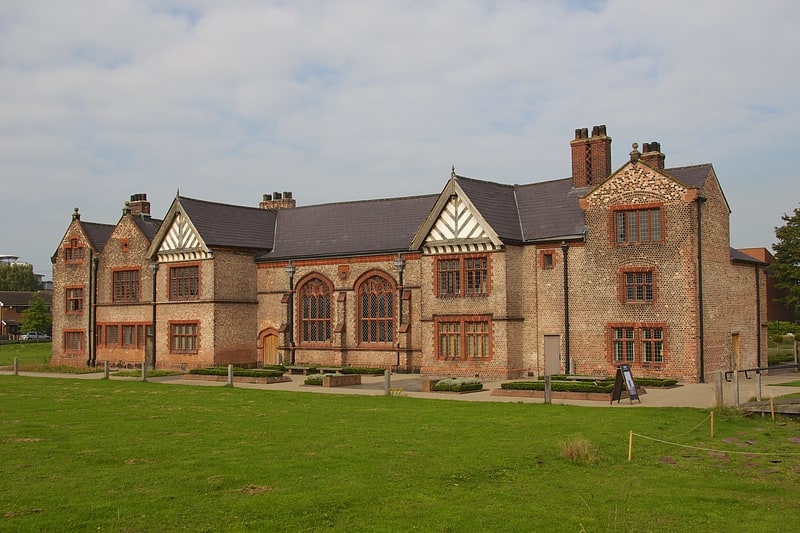
Museum in Salford, England. Ordsall Hall is a large former manor house in the historic parish of Ordsall, Lancashire, England, now part of the City of Salford, in Greater Manchester. It dates back more than 750 years, although the oldest surviving parts of the present hall were built in the 15th century. The most important period of Ordsall Hall's life was as the family seat of the Radclyffe family, who lived in the house for more than 300 years. The hall was the setting for William Harrison Ainsworth's 1842 novel Guy Fawkes, written around the plausible although unsubstantiated local story that the Gunpowder Plot of 1605 was planned in the house.
Since its sale by the Radclyffes in 1662 the hall has been put to many uses: a working men's club, a school for clergy, and a radio station among them. The house was bought by the old Salford Council in 1959 and opened to the public in 1972, as a period house and local history museum. The hall is a Grade I listed building, and entrance is free.[20]
Address: 322 Ordsall Ln, M5 3AN Salford (Salford)
Manchester Arena
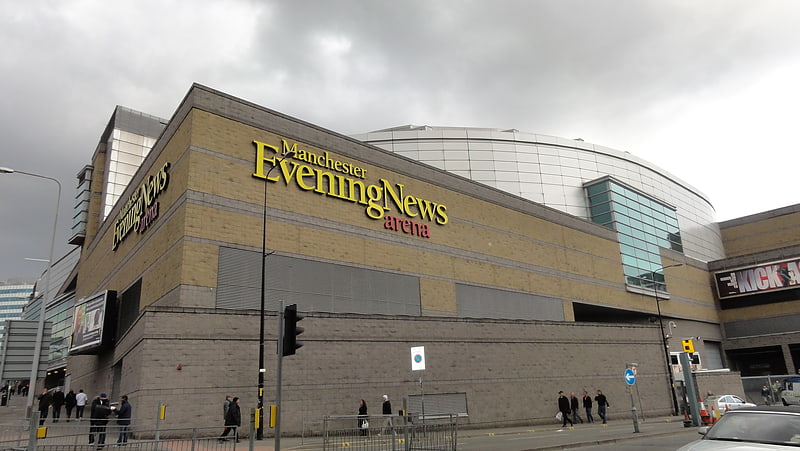
Arena in Manchester, England. The Manchester Arena, known as the AO Arena for sponsorship reasons, is an indoor arena in Manchester, England, immediately north of the city centre and partly above Manchester Victoria station in air rights space. The arena has the highest seating capacity of any indoor venue in the United Kingdom, and the second largest in Europe with a capacity of 21,000
The arena is one of the world's busiest indoor arenas, hosting music and sporting events such as boxing and swimming. The arena was a key part of Manchester's bids to host the Olympic Games in 1996 and 2000 and was eventually used for the 2002 Commonwealth Games.
The arena was temporarily closed following a terror attack on 22 May 2017, in which Libyan suicide bomber Salman Abedi killed 22 people, and injured 500 more, at the end of an Ariana Grande concert during her Dangerous Woman Tour. Shows and events that were scheduled to take place at the arena were either moved to alternative venues, or cancelled completely. The arena was reopened on 9 September with a special benefit concert headlined by Manchester-born singer Noel Gallagher.[21]
Bridgewater Hall
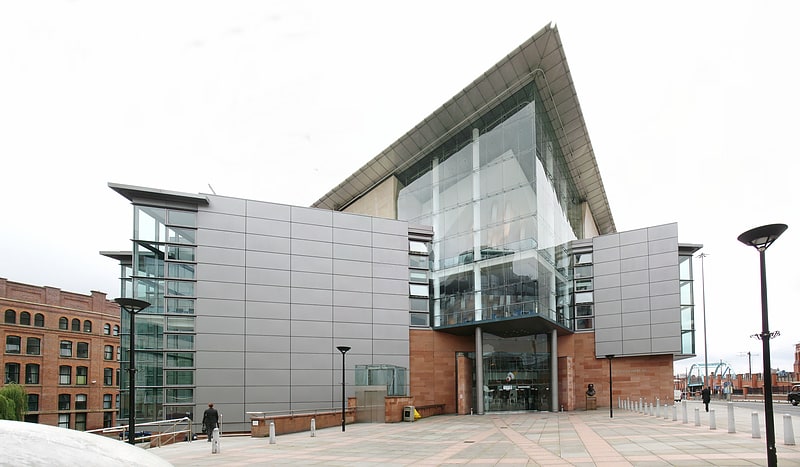
Concert venue in Manchester, England. The Bridgewater Hall is a concert venue in Manchester city centre, England. It cost around £42 million to build in the 1990s, and hosts over 250 performances a year.
The hall is home to The Hallé orchestra and the Hallé Youth Orchestra and Choir, and is the primary concert venue for the BBC Philharmonic. The building sits on a bed of 280 springs, which help to reduce external noise.
The venue is named after the Third Duke of Bridgewater who commissioned the eponymous Bridgewater Canal that crosses Manchester, although the hall and waterside frontage is situated on a specially constructed arm of the Rochdale Canal.[22]
Address: Manchester, The Bridgewater Hall, Lower Mosley Street, Manchester, M2 3WS
Mamucium
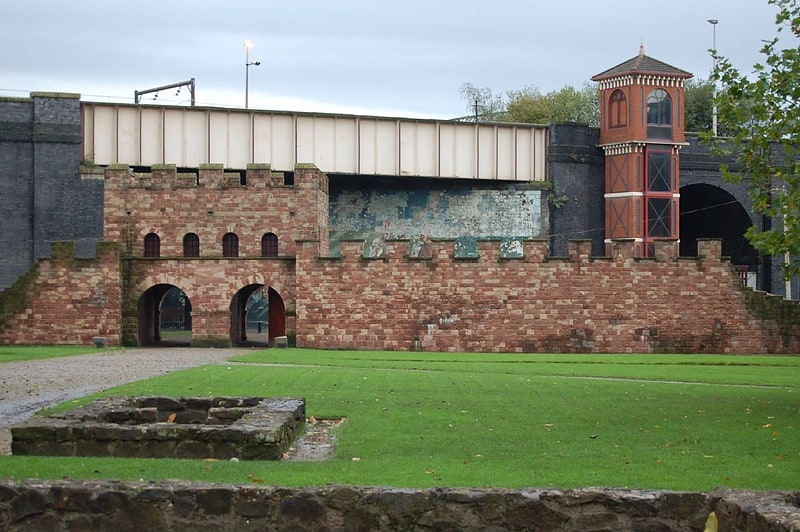
Remains of an ancient Roman fort. Mamucium, also known as Mancunium, is a former Roman fort in the Castlefield area of Manchester in North West England. The castrum, which was founded c. AD 79 within the Roman province of Britannia, was garrisoned by a cohort of Roman Auxiliaries near two major Roman roads running through the area. Several sizeable civilian settlements containing soldiers' families, merchants and industry developed outside the fort. The area is a protected Scheduled Ancient Monument.
The ruins were left undisturbed until Manchester expanded rapidly during the Industrial Revolution in the late 18th century. Most of the fort was levelled to make way for new developments such as the construction of the Rochdale Canal and the Great Northern Railway. The site is now part of the Castlefield Urban Heritage Park that includes renovated warehouses. A section of the fort's wall along with its gatehouse, granaries, and other ancillary buildings from the vicus have been reconstructed and are open to the public.[23]
Address: Off Liverpool Road, Manchester
Belle Vue Stadium
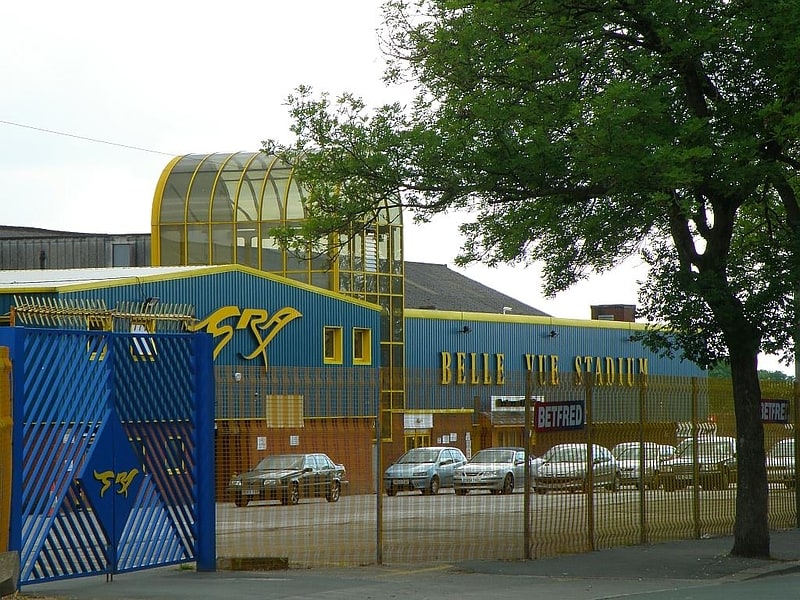
Stadium in Manchester, England. Belle Vue Stadium was a greyhound racing track in Belle Vue, Manchester, England, where the first race around an oval track in Britain was held on 24 July 1926. It has also been used for motorcycle speedway, as the home ground of Elite League team Belle Vue Aces from 1988 until 2015, and from 1999 until 2019 for stock car racing and banger racing.
The track was owned (1926–2014) and operated (1926–2019) by the Greyhound Racing Association. The Crown Oil Pension Fund bought the stadium in 2014. The stadium had luxury glass-fronted grandstands, restaurants, hospitality boxes and bars. Greyhound racing took place during three evenings including Saturday and some afternoons on the Bookmakers Afternoon Greyhound Service (BAGS).[24]
Address: Kirkmanshulme Lane, M18 7BA Manchester
Platt Fields Park
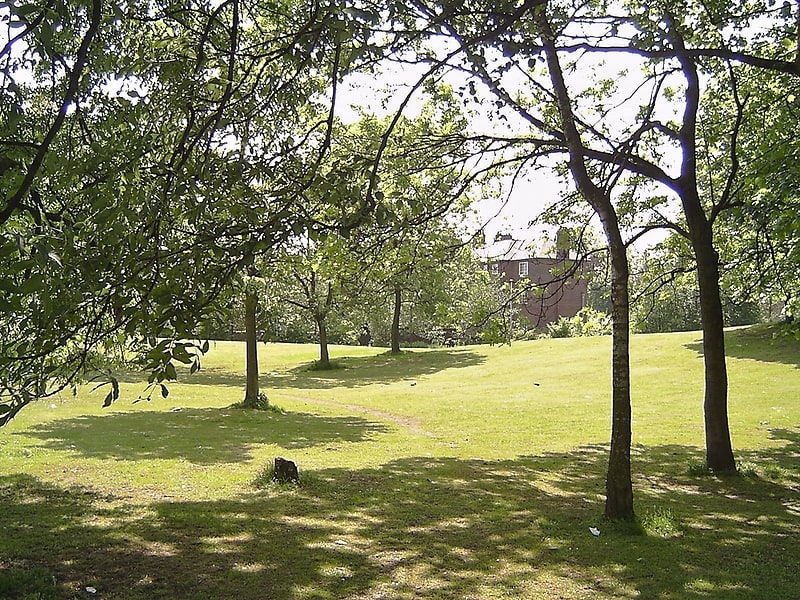
Edwardian public space with boating lake. Platt Fields Park is a large public park in Fallowfield, Manchester, England which is home to Platt Hall. Fallowfield lies to the south and Wilmslow Road runs along its eastern edge.[25]
Address: Wilmslow Rd., M14 6LA Fallowfield
Didsbury Campus
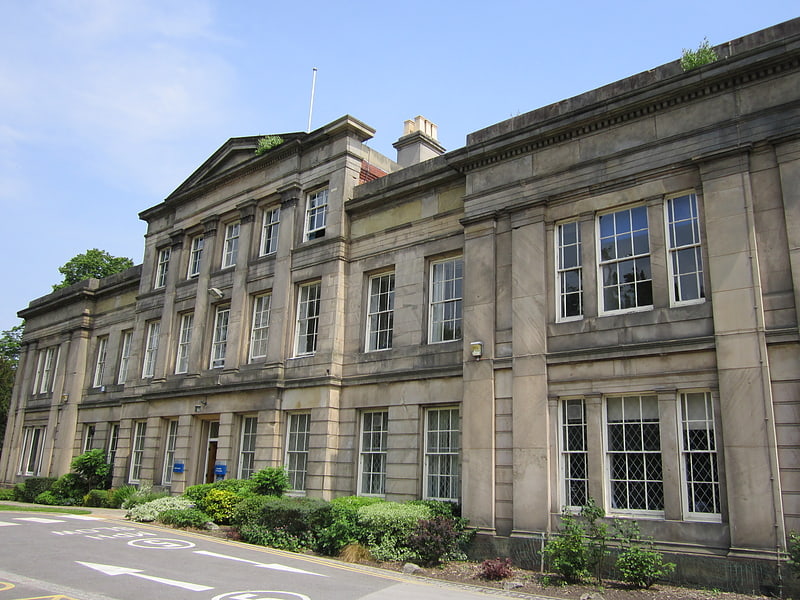
The Didsbury Campus on Wilmslow Road, Didsbury, Manchester, England, originally a private estate, was part of the Manchester Metropolitan University; the oldest building on the site dated to around 1785. It became a theological college for the Wesleyan Methodist Church in 1842, about the same time as a chapel which later became part of the college was built. These buildings are now all listed.
In 1946, in response to a growing need for new teachers across the country, the site became a temporary teacher training college, becoming permanent in 1950. Over the next thirty years there was a significant building programme, with classrooms, lecture theatres, offices, sports facilities and a library all being constructed. The college became a part of Manchester Polytechnic (later Manchester Metropolitan University) in 1977. In 2005, the campus became home to the Science Learning Centre North West.
The university closed the campus in 2014, sold the land to developers, and moved its facilities to a new purpose-built campus named Birley Fields in Hulme. All the buildings constructed after the Second World War were then demolished, with only the listed buildings remaining. As of 2018 these are being converted into homes, as part of the site's redevelopment as a residential area.[26]
People's History Museum
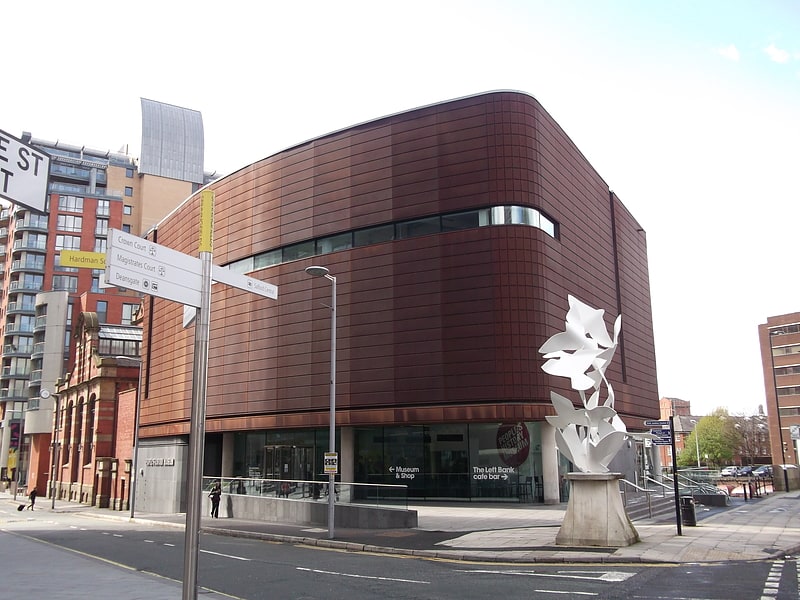
Museum in Manchester, England. The People's History Museum in Manchester, England, is the UK's national centre for the collection, conservation, interpretation and study of material relating to the history of working people in the UK. It is located in a grade II-listed, former hydraulic pumping station on the corner of the Bridge Street and Water Street designed by Manchester Corporation City Architect, Henry Price.
The museum tells the story of the history of in Great Britain and about people's lives at home, work and leisure over the last 200 years. The collection contains printed material, physical objects and photographs of people at work, rest and play. Some of the topics covered include popular radicalism, the Peterloo Massacre, 19th century trade unionism, the women's suffrage movement, dockers, the cooperative movement, the 1945 general election, and football. It also includes material relating to friendly societies, the welfare movement and advances in the lives of working people.[27]
Address: New Ct St, M3 3ER Manchester
William Temple Memorial Church

William Temple Memorial Church is a parish church in Wythenshawe, Manchester, dedicated to the bishop William Temple.
It is a Grade II listed building, designed by George Pace in the Modernist style, and built in 1964–1965. It has a pitched roof with dormer windows.[28]
Wythenshawe Hall
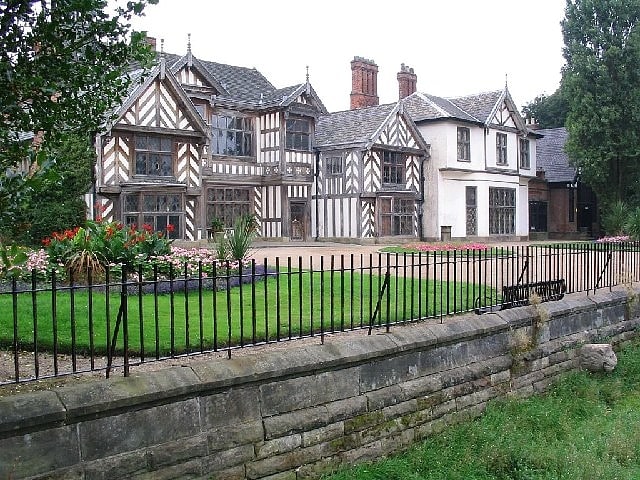
Museum. Wythenshawe Hall is a 16th-century medieval timber-framed historic house and former manor house in Wythenshawe, Manchester, England, five miles south of Manchester city centre in Wythenshawe Park. Built for Robert Tatton, it was home to the Tatton family for almost 400 years. Its basic plan is a central hall with two projecting wings.
In the winter of 1643–44 the house was besieged by Parliamentarian forces during the English Civil War. Despite the stout defence put up by Robert Tatton and his fellow Royalists, the defenders were overwhelmed by the Roundheads' superior weaponry.
Rebuilding work was carried out at the end of the 18th century, and various additions made in the 19th century, including a walled garden, an ice house, glass houses and a tenant's hall. Wythenshawe Hall and its surrounding parkland were donated to Manchester Corporation in 1926, and in 1930 it was opened to the public as a museum.
The building was badly damaged in an arson attack in March 2016; repairs were expected to be completed by late 2019.[29]
Address: Wythenshawe Road, M23 0AB Manchester
Cornerhouse
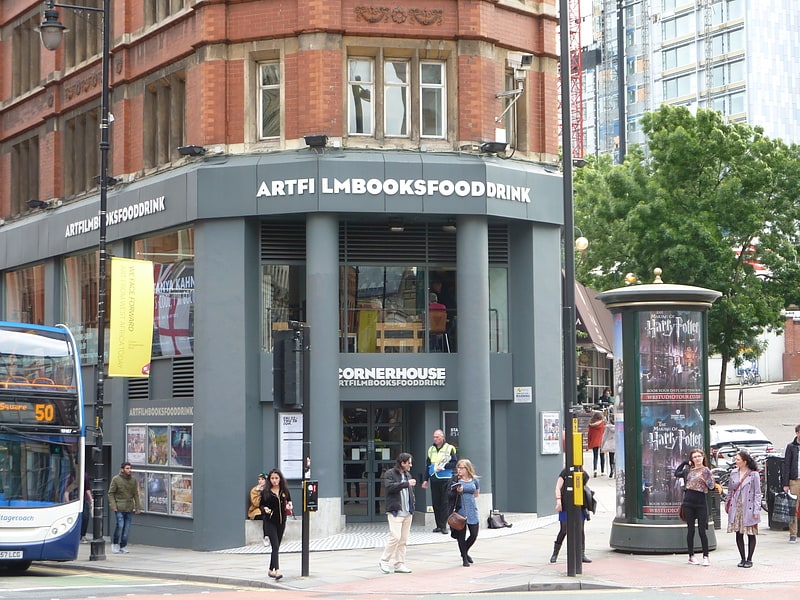
Cornerhouse was a centre for cinema and the contemporary visual arts next to Oxford Road Station on Oxford Street, Manchester, England which was active from 1985–2015. It had three floors of art galleries, three cinemas, a bookshop, a bar and a café bar. Cornerhouse was operated by Greater Manchester Arts Centre Ltd, a registered charity.[30]
Address: 70 Oxford Street, M1 5NH Manchester
Cloud 23
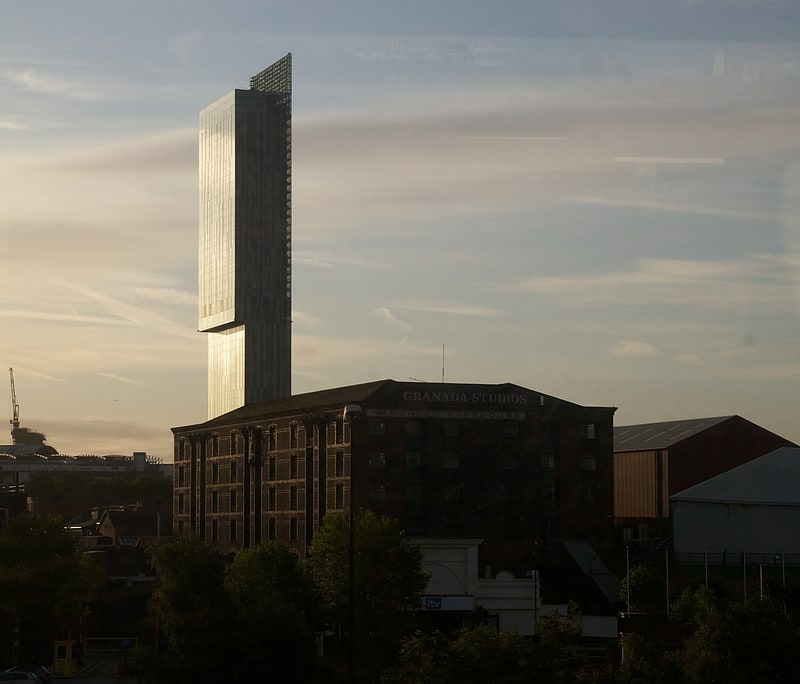
47-floor skyscraper with a hotel. Beetham Tower is a 47-storey mixed use skyscraper in Manchester, England. Completed in 2006, it is named after its developers, the Beetham Organisation, and was designed by SimpsonHaugh and Partners. The development occupies a sliver of land at the top of Deansgate, hence its elongated plan, and was proposed in July 2003, with construction beginning a year later.
At a height of 554 feet (169 m), it was described by the Financial Times as "the UK's first proper skyscraper outside London". From 2006 to 2018, the skyscraper was the tallest building in Manchester and outside London in the United Kingdom. In November 2018, it was surpassed by the South Tower at Deansgate Square, which is 659 feet (201 m) tall.
As a result of the elongated floor plan, the structure is one of the thinnest skyscrapers in the world with a height to width ratio of 10:1 on the east–west façade, but is noticeably wider on the north–south façade. A four-metre cantilever marks the transition between hotel and residential use on the north façade, and a blade structure on the south side of the building acts as a façade overrun accentuating its slim form and doubles as a lightning rod. The skyscraper is visible from ten English counties on a clear day.
The top floor penthouse offers views of Greater Manchester, the Cheshire Plain, the Pennines and Snowdonia. The tower is known for emitting a loud unintentional hum or howl in windy weather, believed to emanate from the glass 'blade' atop the building. The hum has been recorded as a B below middle C and can be heard over large parts of the local area.
Architectural response to the skyscraper is polarised and interpretations vary. Some questioned its dominant appearance over the city, particularly over listed buildings, with one author going as far to say the skyscraper instantly "torpedoed" any possibility of Manchester becoming a UNESCO World Heritage City – a status Manchester was previously on the United Kingdom shortlist for due its industrial past. Others feel its dramatic appearance and peculiarity is reflective of Manchester, and that the Beetham Tower symbolises Manchester's reinvention as a post-industrial city, particularly since the bombing of 1996. Nevertheless, it has received praise and was awarded the best tall building in the world in 2007 by the Council for Tall Buildings and Urban Habitat. In 2019, it was the subject of a legal dispute over the need for urgent repair works to parts of the glass panel façade.[31]
Address: 303 Deansgate, M3 4LQ Manchester
Church of St Mary the Virgin
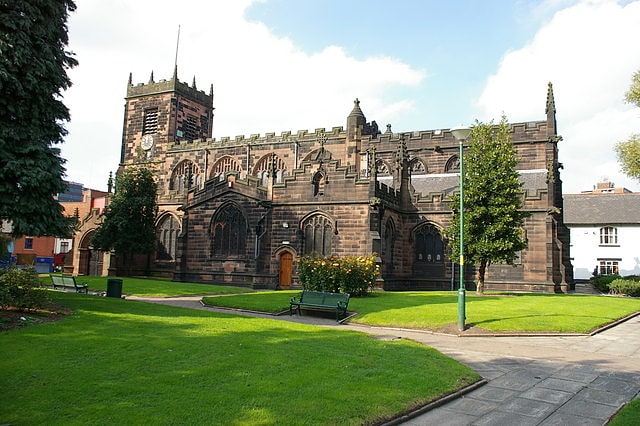
Parish church in Eccles, England. St Mary the Virgin's Church is an active Anglican parish church in Eccles, Greater Manchester, England. The church is in the Eccles deanery, the archdeaconry of Salford and the diocese of Manchester. Together with St Andrew's Eccles, St Paul's, Monton, Christ Church, Patricroft and St James', Hope the church is part of the team benefice of Eccles. The church was granted Grade I Listed status in 1964.[32]
Address: Church Rd, M30 0DL Manchester (Salford)
AJ Bell Stadium

Stadium in Eccles, England. Salford City Stadium is a rugby league stadium in Barton-upon-Irwell, England, built to replace Salford rugby league club's ground the Willows for the 2012 season. Sale Sharks rugby union club have also played at the stadium since the 2012–13 season.[33]
Address: Salford Red Devils / Sale Sharks, M30 7EY Eccles (Salford)
Manchester Reform Synagogue

Synagogue in Manchester, England. Manchester Reform Synagogue, a member of the Movement for Reform Judaism, is one of the oldest Reform Jewish communities in the United Kingdom. Founded in 1857 with congregation president Horatio Michollis und Rabbi Solomon Marcus Schiller-Szinessy under the name Manchester Congregation of British Jews by a group consisting mainly of German-Jewish immigrants, the synagogue is located in central Manchester at Jackson's Row. The congregation bought that site in 1949.
Albert Isaacs, Alexander Levy, and Frederick Lister laid the cornerstone on 18 May 1952. After completion the synagogue was inaugurated on 28 November 1953. John Bradshaw designed the stained glass windows which were manufactured by the stained glass company Charles Lightfoot.
The current structure was financed by money from the War Damage Commission, after the previous synagogue building on Park Place was destroyed on 1 June 1941 during the Second World War in the Manchester Blitz.
The current building has a large synagogue, banqueting hall and classrooms. The building was designed by Peter Cummings and Eric Levy. In 2014, it was reported that the building would be demolished and rebuilt, to make way for a development of shops, flats and a luxury hotel.
The synagogue building at Jackson's Row was used as a filming location for the 2021 BBC TV series Ridley Road.[34]
Salford Museum and Art Gallery
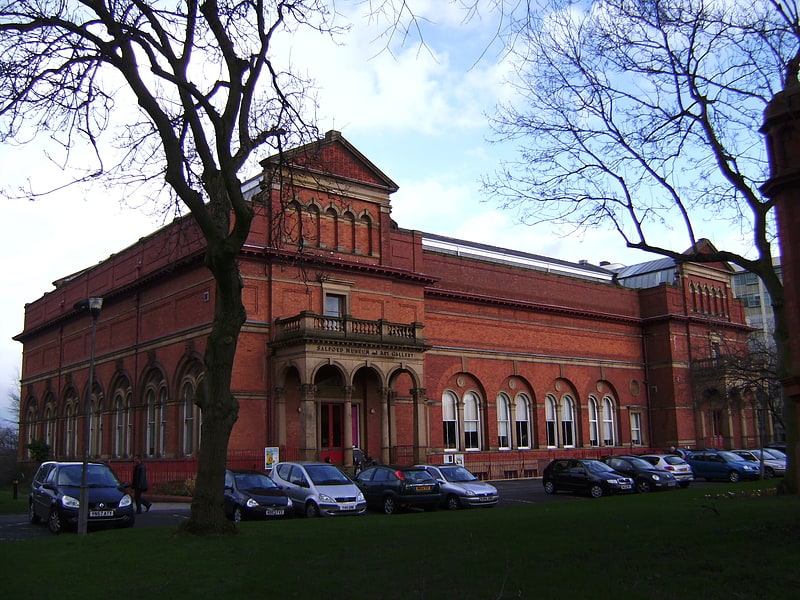
Museum in Salford, England. Salford Museum and Art Gallery, in Peel Park, Salford, Greater Manchester, opened to the public in November 1850 as the Royal Museum and Public Library. The gallery and museum are devoted to the history of Salford and Victorian art and architecture.[35]
Address: Peel Park, M5 4WU Salford (Salford)